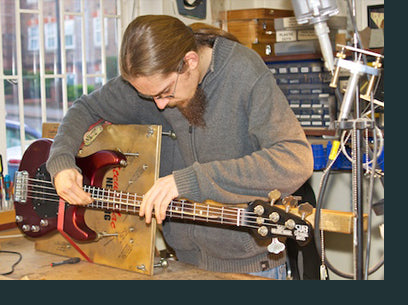Fretwork
Fretwork – our speciality
The frets on your guitar are just about the most important thing affecting the playability of the instrument, and as such deserve special attention.
Whilst most guitars will benefit from a set-up, often you won’t get the full benefit from that process because of issues with the frets:
It may be that there is wear in certain areas of the frets, or that through shrinkage in the fingerboard (or other reasons), some frets are slightly higher than others resulting in rattle, buzz or choking when bending strings.
This is something that would usually be diagnosed in our free health check process.
Other times players just want to get the most out of their guitars and careful fretwork is the key to achieving this. By getting the frets all perfectly level with each other, and then doing a careful set-up a much better end result is achieved.
This is the process that starts to give us the control we need to make your guitar play to it’s fullest capacity. All guitars in their lifetime will benefit from a fret dress at some point or other.
The Erlewine/Stewmac neck jig
We were early adopters of the neck jig in 1999 and have used it ever since for EVERY full fret dress we do. We wouldn’t want to be without it, especially as we know how to get the best out of it.
So What does the 'neck-jig' do?
It allows us to recreate the same tensions on a neck as created by the pull of the strings, but without the strings on, thus allowing you to work on the frets, with the neck in it’s optimum state to be levelled.
What some others might call a fret dress – running a worn out oilstone up and down the frets, often simply following the humps and bumps already in the neck, thus failing to eliminate the problems, isn't the way to do it.
We prefer to skim ALL the frets at once with a precision ground leveller to ensure that we are working on a completely level surface and that all the frets are taken into account when we level.
- This removes any high spots from end to end.
- We level in the “lie of the strings” even if the fingerboard’s radius is based on a true cylinder. This will create a slight compound radius which again is essential for low action with choke free string bends.
- We also introduce a small amount of “fall-away” into the last few frets. This allows for the elliptical movement of the strings not to end up hitting the last frets as you play higher up the fingerboard.
- We also introduce an exaggerated compound radius at the top end of the board on the treble side to try to help with big bends on the high E (and B) strings.
- The frets are neatly re-profiled to a proper clean domed shape using a diamond coated tool followed by higher grades of abrasive paper, and finally polished to a high gloss finish.
- For a more in depth look at the neck jig in action - click HERE or on the pic below

NOW we can do a good set-up on the guitar.
Re-fretting
This process allows us the most control over the whole set-up process as we can correct any imperfections in the fingerboard, as well as controlling the frets. We keep a wide selection of wires in stock from vintage to super-jumbo.
There are a number of reasons for a re-fret to be required:
- Maybe the frets are worn out or badly pitted, and simply dressing the frets to remove the wear would leave a fret that is too low for the players comfort or to let the guitar play at it’s best.
- Sometimes the height or profile of the existing frets are not ideal for the player and they would like to change gauge.
Whichever is the case we can help. The time consuming processes involved in doing a re-fret are very important to the end result. The better your preparation, then the better the end result will be.
We take a lot of care in the treatment of the fingerboard itself to give the best possible surface to install the new frets.
Our installation process is equally detailed, with utmost care being taken to ensure a firm and tidy seating of each fret – to maximise tone & neck stiffness, also ensuring consistent feel and reliability for years to come.
The way we finish the ends of our frets flush to the edge of the board in a way that you hardly feel them and never snag yourself on the ends is almost our trademark.
Subsequent to this we then fret dress and set-up the guitar as per above.







